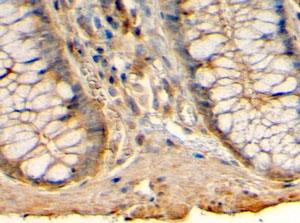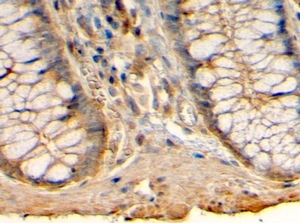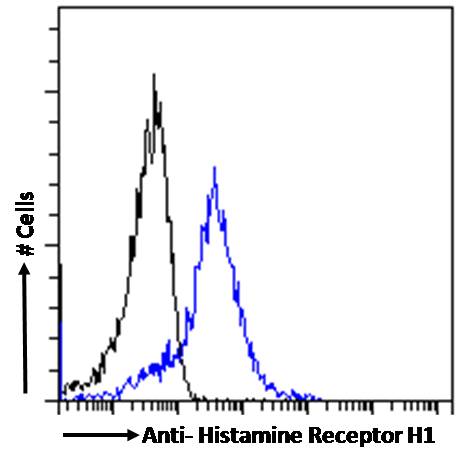Histamine Receptor H1 (C Term) Antibody (C-Term)
Peptide-affinity purified goat antibody
- SPECIFICATION
- CITATIONS: 1
- PROTOCOLS
- BACKGROUND

Application
| IHC, IF, FC, Pep-ELISA |
|---|---|
| Primary Accession | P35367 |
| Other Accession | NP_000852.1, NP_001091681.1, NP_001091682.1, NP_001091683.1, 3269, 15465 (mouse), 24448 (rat) |
| Reactivity | Human |
| Predicted | Mouse, Rat, Dog |
| Host | Goat |
| Clonality | Polyclonal |
| Concentration | 0.5 mg/ml |
| Isotype | IgG |
| Calculated MW | 55784 Da |
| Gene ID | 3269 |
|---|---|
| Other Names | Histamine H1 receptor, H1R, HH1R, HRH1 |
| Dilution | IHC~~1:100~500 IF~~1:50~200 FC~~1:10~50 Pep-ELISA~~N/A |
| Format | 0.5 mg/ml in Tris saline, 0.02% sodium azide, pH7.3 with 0.5% bovine serum albumin |
| Storage | Maintain refrigerated at 2-8°C for up to 6 months. For long term storage store at -20°C in small aliquots to prevent freeze-thaw cycles. |
| Precautions | Histamine Receptor H1 (C Term) Antibody (C-Term) is for research use only and not for use in diagnostic or therapeutic procedures. |
| Name | HRH1 (HGNC:5182) |
|---|---|
| Function | G-protein-coupled receptor for histamine, a biogenic amine that functions as an immune modulator and a neurotransmitter (PubMed:33828102, PubMed:8280179). Through the H1 receptor, histamine mediates the contraction of smooth muscles and increases capillary permeability due to contraction of terminal venules. Also mediates neurotransmission in the central nervous system and thereby regulates circadian rhythms, emotional and locomotor activities as well as cognitive functions (By similarity). |
| Cellular Location | Cell membrane; Multi-pass membrane protein |

Provided below are standard protocols that you may find useful for product applications.
Background
Variants (NP_000852.1; NP_001091681.1; NP_001091682.1; NP_001091683.1) encode the same protein.
References
Beta(2)-adrenergic receptor-mediated histamine H(1) receptor down-regulation: another possible advantage of beta(2) agonists in asthmatic therapy. Kawakami N, Miyoshi K, Horio S, Fukui H. J Pharmacol Sci. 2004 Apr;94(4):449-58. PMID: 15107586
If you have used an Abcepta product and would like to share how it has performed, please click on the "Submit Review" button and provide the requested information. Our staff will examine and post your review and contact you if needed.
If you have any additional inquiries please email technical services at tech@abcepta.com.














 Foundational characteristics of cancer include proliferation, angiogenesis, migration, evasion of apoptosis, and cellular immortality. Find key markers for these cellular processes and antibodies to detect them.
Foundational characteristics of cancer include proliferation, angiogenesis, migration, evasion of apoptosis, and cellular immortality. Find key markers for these cellular processes and antibodies to detect them. The SUMOplot™ Analysis Program predicts and scores sumoylation sites in your protein. SUMOylation is a post-translational modification involved in various cellular processes, such as nuclear-cytosolic transport, transcriptional regulation, apoptosis, protein stability, response to stress, and progression through the cell cycle.
The SUMOplot™ Analysis Program predicts and scores sumoylation sites in your protein. SUMOylation is a post-translational modification involved in various cellular processes, such as nuclear-cytosolic transport, transcriptional regulation, apoptosis, protein stability, response to stress, and progression through the cell cycle. The Autophagy Receptor Motif Plotter predicts and scores autophagy receptor binding sites in your protein. Identifying proteins connected to this pathway is critical to understanding the role of autophagy in physiological as well as pathological processes such as development, differentiation, neurodegenerative diseases, stress, infection, and cancer.
The Autophagy Receptor Motif Plotter predicts and scores autophagy receptor binding sites in your protein. Identifying proteins connected to this pathway is critical to understanding the role of autophagy in physiological as well as pathological processes such as development, differentiation, neurodegenerative diseases, stress, infection, and cancer.





